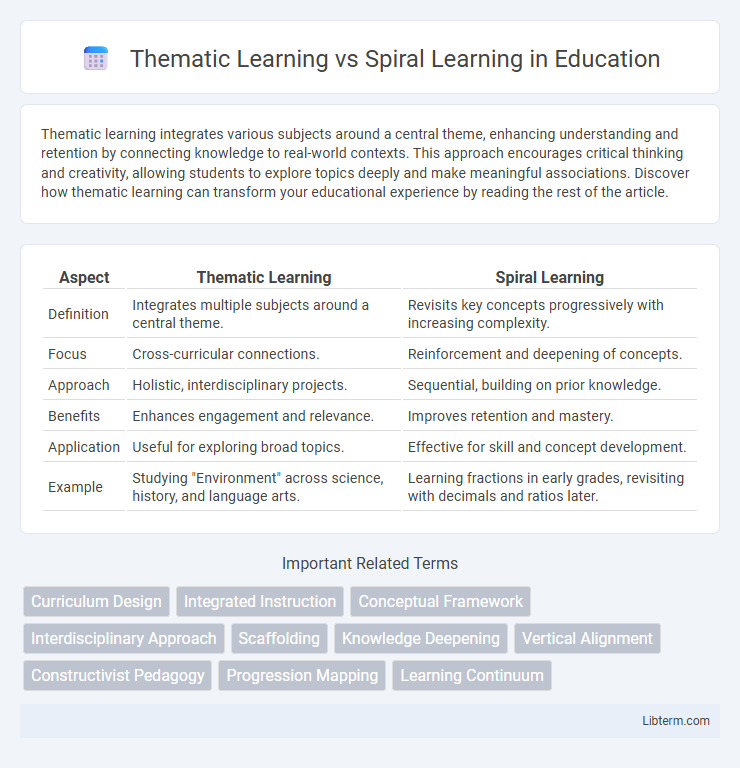Thematic learning integrates various subjects around a central theme, enhancing understanding and retention by connecting knowledge to real-world contexts. This approach encourages critical thinking and creativity, allowing students to explore topics deeply and make meaningful associations. Discover how thematic learning can transform your educational experience by reading the rest of the article.
Table of Comparison
| Aspect | Thematic Learning | Spiral Learning |
|---|---|---|
| Definition | Integrates multiple subjects around a central theme. | Revisits key concepts progressively with increasing complexity. |
| Focus | Cross-curricular connections. | Reinforcement and deepening of concepts. |
| Approach | Holistic, interdisciplinary projects. | Sequential, building on prior knowledge. |
| Benefits | Enhances engagement and relevance. | Improves retention and mastery. |
| Application | Useful for exploring broad topics. | Effective for skill and concept development. |
| Example | Studying "Environment" across science, history, and language arts. | Learning fractions in early grades, revisiting with decimals and ratios later. |
Introduction to Thematic and Spiral Learning
Thematic learning organizes education around central themes, promoting interdisciplinary connections and deeper understanding by integrating subjects through common topics. Spiral learning revisits key concepts repeatedly at increasing levels of complexity, reinforcing knowledge and facilitating long-term retention. Both approaches enhance cognitive development by aligning content delivery with natural learning progression and contextual relevance.
Core Principles of Thematic Learning
Thematic Learning centers on integrating multiple subjects around a central theme, fostering deeper understanding and relevance by connecting knowledge across disciplines. Core principles include student-centered inquiry, real-world context application, and holistic learning experiences that promote critical thinking and creativity. This approach contrasts with Spiral Learning, which revisits topics progressively with increasing complexity to reinforce retention and mastery.
Core Principles of Spiral Learning
Spiral learning is based on the core principle of revisiting key concepts repeatedly over time, each encounter increasing in complexity and reinforcing previous knowledge. This approach emphasizes cumulative understanding by expanding on foundational ideas through successive layers, promoting long-term retention and mastery. Unlike thematic learning, which centers on integrating content around broad themes, spiral learning structures curriculum sequentially to deepen comprehension through iterative exposure.
Differences Between Thematic and Spiral Approaches
Thematic learning organizes curriculum around overarching themes, promoting interdisciplinary connections and contextual understanding by integrating multiple subjects through real-world topics. Spiral learning revisits key concepts regularly, increasing in complexity each time to reinforce retention and deepen comprehension through repeated exposure. Thematic learning emphasizes breadth within a thematic context, while spiral learning focuses on progressive mastery through cyclical review.
Benefits of Thematic Learning in Education
Thematic learning enhances student engagement by connecting subjects through relevant, real-world themes, fostering deeper understanding and retention. This approach encourages critical thinking and creativity by allowing students to explore concepts across multiple disciplines contextually. Integrating thematic learning promotes collaboration and communication skills, preparing learners for complex problem-solving in diverse environments.
Benefits of Spiral Learning in Education
Spiral learning enhances knowledge retention by revisiting key concepts at increasing levels of complexity, reinforcing understanding and mastery over time. This method supports cognitive development through continuous connections between new information and prior knowledge, fostering deeper comprehension. Educators benefit from spiral learning's flexible structure, allowing them to tailor lessons that adapt to individual student progress and promote sustained academic growth.
Challenges of Implementing Thematic Learning
Implementing thematic learning faces challenges such as aligning interdisciplinary themes with standardized curricula and assessment frameworks, which often emphasize discrete subject mastery. Teachers require extensive training to design cohesive thematic units that integrate multiple subjects meaningfully, demanding significant time and resource investment. Resistance from stakeholders accustomed to traditional subject-based instruction can further hinder effective adoption of thematic learning methodologies.
Challenges of Implementing Spiral Learning
Implementing spiral learning faces challenges such as ensuring curriculum coherence and maintaining learner motivation through repeated exposure to progressively complex concepts. Teachers often require extensive training to design lessons that effectively revisit topics while deepening understanding, which can complicate instructional planning. Resource limitations and standardized testing demands further hinder the consistent application of spiral learning in educational settings.
Choosing the Right Approach: Key Considerations
Choosing the right approach between thematic learning and spiral learning depends on curriculum goals, student engagement levels, and content complexity. Thematic learning integrates subjects around core themes, enhancing conceptual connections and real-world application, while spiral learning revisits topics with increasing depth, reinforcing retention and mastery over time. Educators should assess learner needs, instructional time, and assessment strategies to optimize knowledge acquisition and skill development effectively.
Integrating Thematic and Spiral Learning Strategies
Integrating thematic and spiral learning strategies enhances student engagement and knowledge retention by connecting related concepts through recurring, increasingly complex themes. This combined approach enables learners to revisit core topics across different contexts and grade levels, solidifying understanding while promoting deeper cognitive development. Implementing a curriculum that weaves thematic units with spiral revisiting optimizes instructional coherence and supports long-term mastery of skills and content.
Thematic Learning Infographic

 libterm.com
libterm.com